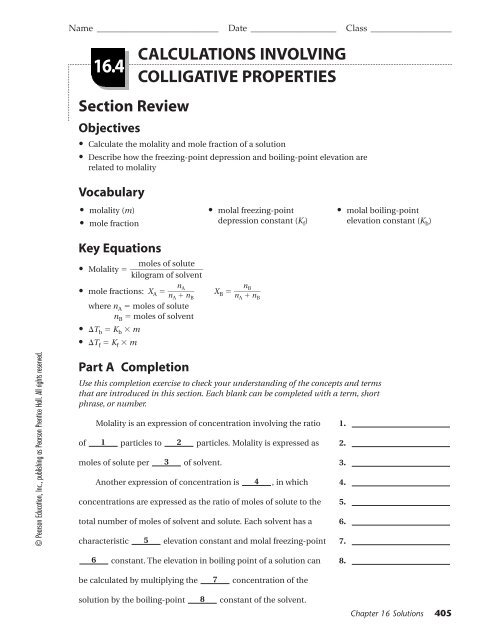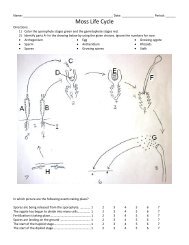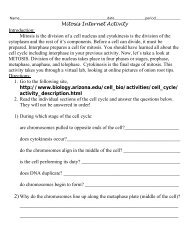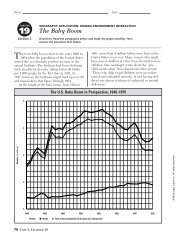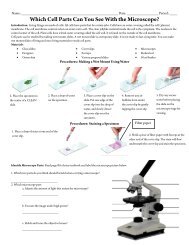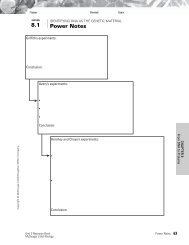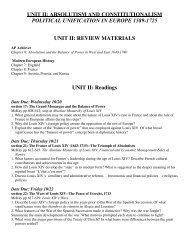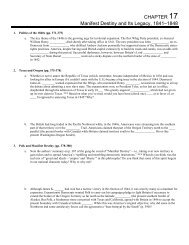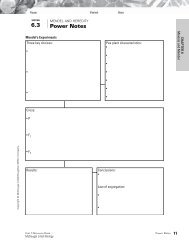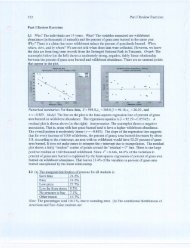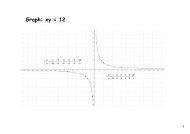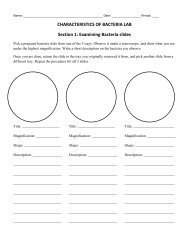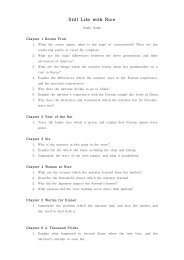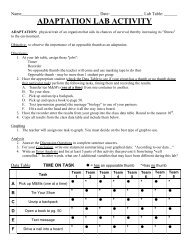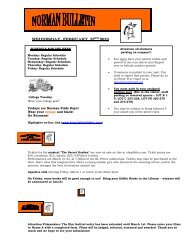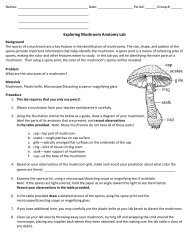calculations involving colligative properties 16.4
calculations involving colligative properties 16.4
calculations involving colligative properties 16.4
Create successful ePaper yourself
Turn your PDF publications into a flip-book with our unique Google optimized e-Paper software.
© Pearson Education, Inc., publishing as Pearson Prentice Hall. All rights reserved.<br />
Name ___________________________ Date ___________________ Class __________________<br />
<strong>16.4</strong><br />
Section Review<br />
Objectives<br />
• Calculate the molality and mole fraction of a solution<br />
• Describe how the freezing-point depression and boiling-point elevation are<br />
related to molality<br />
Vocabulary<br />
• molality (m)<br />
• mole fraction<br />
Key Equations<br />
moles of solute<br />
• Molality <br />
kilogram of solvent<br />
nA<br />
• mole fractions: XA <br />
nA nB where nA moles of solute<br />
nB moles of solvent<br />
• Tb Kb m<br />
• Tf Kf m<br />
Part A Completion<br />
nB<br />
XB nA nB Use this completion exercise to check your understanding of the concepts and terms<br />
that are introduced in this section. Each blank can be completed with a term, short<br />
phrase, or number.<br />
Molality is an expression of concentration <strong>involving</strong> the ratio 1.<br />
of 1 particles to 2 particles. Molality is expressed as 2.<br />
moles of solute per 3 of solvent. 3.<br />
Another expression of concentration is 4 , in which 4.<br />
concentrations are expressed as the ratio of moles of solute to the 5.<br />
total number of moles of solvent and solute. Each solvent has a 6.<br />
characteristic 5 elevation constant and molal freezing-point 7.<br />
6<br />
CALCULATIONS INVOLVING<br />
COLLIGATIVE PROPERTIES<br />
• molal freezing-point<br />
depression constant (K f )<br />
constant. The elevation in boiling point of a solution can 8.<br />
be calculated by multiplying the 7 concentration of the<br />
solution by the boiling-point 8 constant of the solvent.<br />
• molal boiling-point<br />
elevation constant (K b )<br />
Chapter 16 Solutions 405
Name ___________________________ Date ___________________ Class __________________<br />
Part B True-False<br />
Classify each of these statements as always true, AT; sometimes true, ST; or never true, NT.<br />
________ 9. It is possible to calculate the molar mass of a solute if you know the<br />
K b or K f of a solvent.<br />
________ 10. Molal concentration is the same as molar concentration.<br />
________ 11. The depression in freezing point of a solution is proportional to the<br />
molal concentration of solute.<br />
________ 12. The sum of X A and X B for any solution is always 1.<br />
Part C Matching<br />
Match each description in Column B to the correct term in Column A.<br />
Column A<br />
________ 13. molality<br />
________ 14. mole fraction<br />
________ 15. molal freezing-point<br />
depression constant<br />
________ 16. molal boiling-point<br />
elevation constant<br />
________ 17. molar mass<br />
Part D Problem<br />
Solve the following problem in the space provided. Show your work.<br />
18. What is the freezing point of a solution that contains 2.0 mol of CaCl2 in 800.0 g<br />
of water? Kf for water 1.86C/m<br />
406 Core Teaching Resources<br />
Column B<br />
a. a constant for a given solvent equal to the change in<br />
boiling point for a 1m solution<br />
b. number of moles of solute dissolved in 1 kilogram of<br />
solvent<br />
c. mass of one mole of a substance<br />
d. a constant for a given solvent equal to the change in<br />
freezing point for a 1m solution<br />
e. ratio of moles of solute in solution to the total number<br />
of moles of solute and solvent<br />
© Pearson Education, Inc., publishing as Pearson Prentice Hall. All rights reserved.


